Impact of Mergers on Shareholder Value: A Coventry University Study
VerifiedAdded on 2022/12/19
|18
|5883
|443
Thesis and Dissertation
AI Summary
This dissertation explores whether mergers create shareholder value, examining their impact on stakeholder performance and engagement. It reviews literature on merger types, value creation, and stakeholder influence. The research aims to analyse the positive and negative effects of mergers, focusing on stakeholder value and performance. It investigates the meaning of mergers, their value creation mechanisms, and potential negative influences. The study considers integrative synergies, emergent value, and the importance of post-merger integration, highlighting the complexities and challenges in achieving successful mergers and creating lasting value for all stakeholders. Desklib provides a platform for students to access similar solved assignments and past papers.
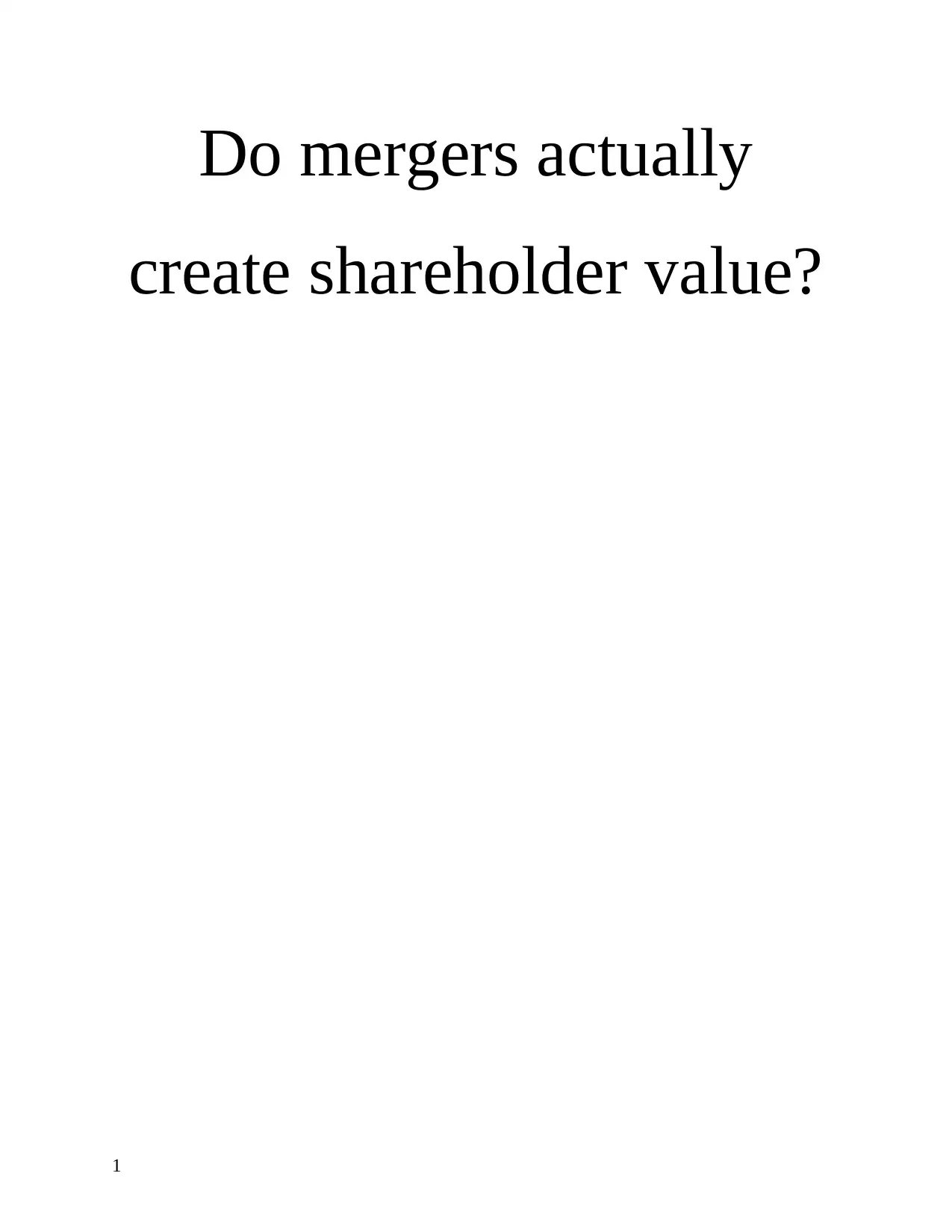
Do mergers actually
create shareholder value?
1
create shareholder value?
1
Paraphrase This Document
Need a fresh take? Get an instant paraphrase of this document with our AI Paraphraser
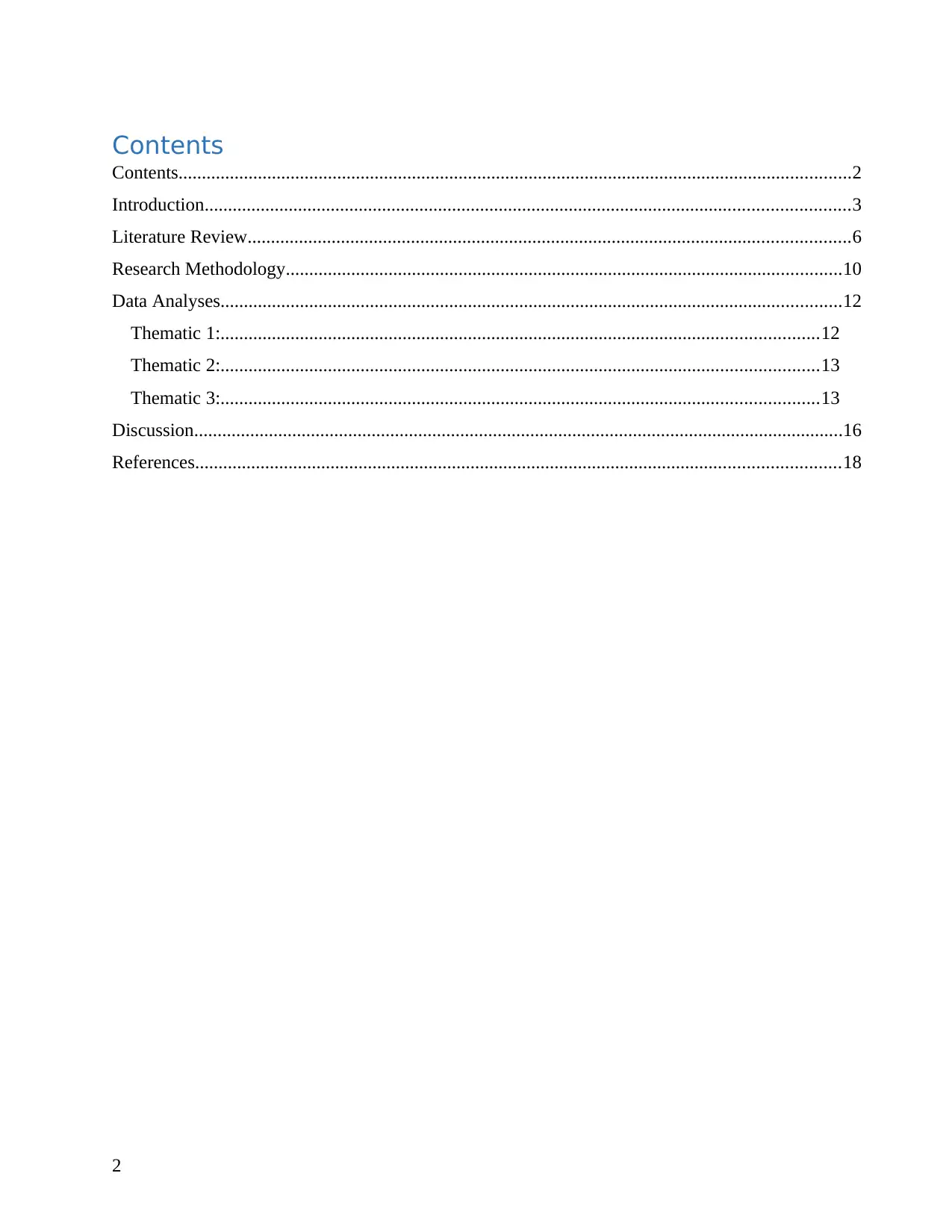
Contents
Contents................................................................................................................................................2
Introduction..........................................................................................................................................3
Literature Review.................................................................................................................................6
Research Methodology.......................................................................................................................10
Data Analyses.....................................................................................................................................12
Thematic 1:................................................................................................................................12
Thematic 2:................................................................................................................................13
Thematic 3:................................................................................................................................13
Discussion...........................................................................................................................................16
References..........................................................................................................................................18
2
Contents................................................................................................................................................2
Introduction..........................................................................................................................................3
Literature Review.................................................................................................................................6
Research Methodology.......................................................................................................................10
Data Analyses.....................................................................................................................................12
Thematic 1:................................................................................................................................12
Thematic 2:................................................................................................................................13
Thematic 3:................................................................................................................................13
Discussion...........................................................................................................................................16
References..........................................................................................................................................18
2
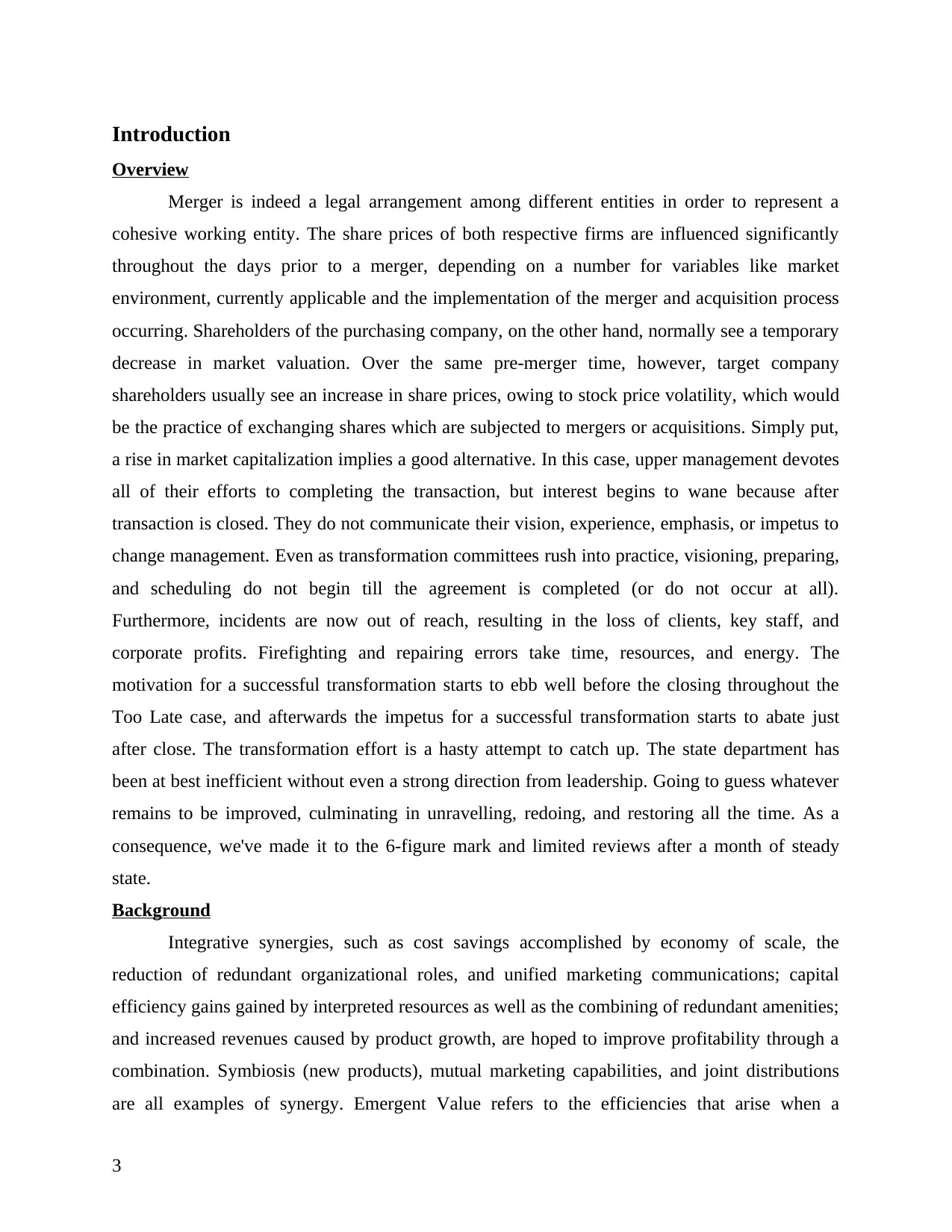
Introduction
Overview
Merger is indeed a legal arrangement among different entities in order to represent a
cohesive working entity. The share prices of both respective firms are influenced significantly
throughout the days prior to a merger, depending on a number for variables like market
environment, currently applicable and the implementation of the merger and acquisition process
occurring. Shareholders of the purchasing company, on the other hand, normally see a temporary
decrease in market valuation. Over the same pre-merger time, however, target company
shareholders usually see an increase in share prices, owing to stock price volatility, which would
be the practice of exchanging shares which are subjected to mergers or acquisitions. Simply put,
a rise in market capitalization implies a good alternative. In this case, upper management devotes
all of their efforts to completing the transaction, but interest begins to wane because after
transaction is closed. They do not communicate their vision, experience, emphasis, or impetus to
change management. Even as transformation committees rush into practice, visioning, preparing,
and scheduling do not begin till the agreement is completed (or do not occur at all).
Furthermore, incidents are now out of reach, resulting in the loss of clients, key staff, and
corporate profits. Firefighting and repairing errors take time, resources, and energy. The
motivation for a successful transformation starts to ebb well before the closing throughout the
Too Late case, and afterwards the impetus for a successful transformation starts to abate just
after close. The transformation effort is a hasty attempt to catch up. The state department has
been at best inefficient without even a strong direction from leadership. Going to guess whatever
remains to be improved, culminating in unravelling, redoing, and restoring all the time. As a
consequence, we've made it to the 6-figure mark and limited reviews after a month of steady
state.
Background
Integrative synergies, such as cost savings accomplished by economy of scale, the
reduction of redundant organizational roles, and unified marketing communications; capital
efficiency gains gained by interpreted resources as well as the combining of redundant amenities;
and increased revenues caused by product growth, are hoped to improve profitability through a
combination. Symbiosis (new products), mutual marketing capabilities, and joint distributions
are all examples of synergy. Emergent Value refers to the efficiencies that arise when a
3
Overview
Merger is indeed a legal arrangement among different entities in order to represent a
cohesive working entity. The share prices of both respective firms are influenced significantly
throughout the days prior to a merger, depending on a number for variables like market
environment, currently applicable and the implementation of the merger and acquisition process
occurring. Shareholders of the purchasing company, on the other hand, normally see a temporary
decrease in market valuation. Over the same pre-merger time, however, target company
shareholders usually see an increase in share prices, owing to stock price volatility, which would
be the practice of exchanging shares which are subjected to mergers or acquisitions. Simply put,
a rise in market capitalization implies a good alternative. In this case, upper management devotes
all of their efforts to completing the transaction, but interest begins to wane because after
transaction is closed. They do not communicate their vision, experience, emphasis, or impetus to
change management. Even as transformation committees rush into practice, visioning, preparing,
and scheduling do not begin till the agreement is completed (or do not occur at all).
Furthermore, incidents are now out of reach, resulting in the loss of clients, key staff, and
corporate profits. Firefighting and repairing errors take time, resources, and energy. The
motivation for a successful transformation starts to ebb well before the closing throughout the
Too Late case, and afterwards the impetus for a successful transformation starts to abate just
after close. The transformation effort is a hasty attempt to catch up. The state department has
been at best inefficient without even a strong direction from leadership. Going to guess whatever
remains to be improved, culminating in unravelling, redoing, and restoring all the time. As a
consequence, we've made it to the 6-figure mark and limited reviews after a month of steady
state.
Background
Integrative synergies, such as cost savings accomplished by economy of scale, the
reduction of redundant organizational roles, and unified marketing communications; capital
efficiency gains gained by interpreted resources as well as the combining of redundant amenities;
and increased revenues caused by product growth, are hoped to improve profitability through a
combination. Symbiosis (new products), mutual marketing capabilities, and joint distributions
are all examples of synergy. Emergent Value refers to the efficiencies that arise when a
3
⊘ This is a preview!⊘
Do you want full access?
Subscribe today to unlock all pages.

Trusted by 1+ million students worldwide
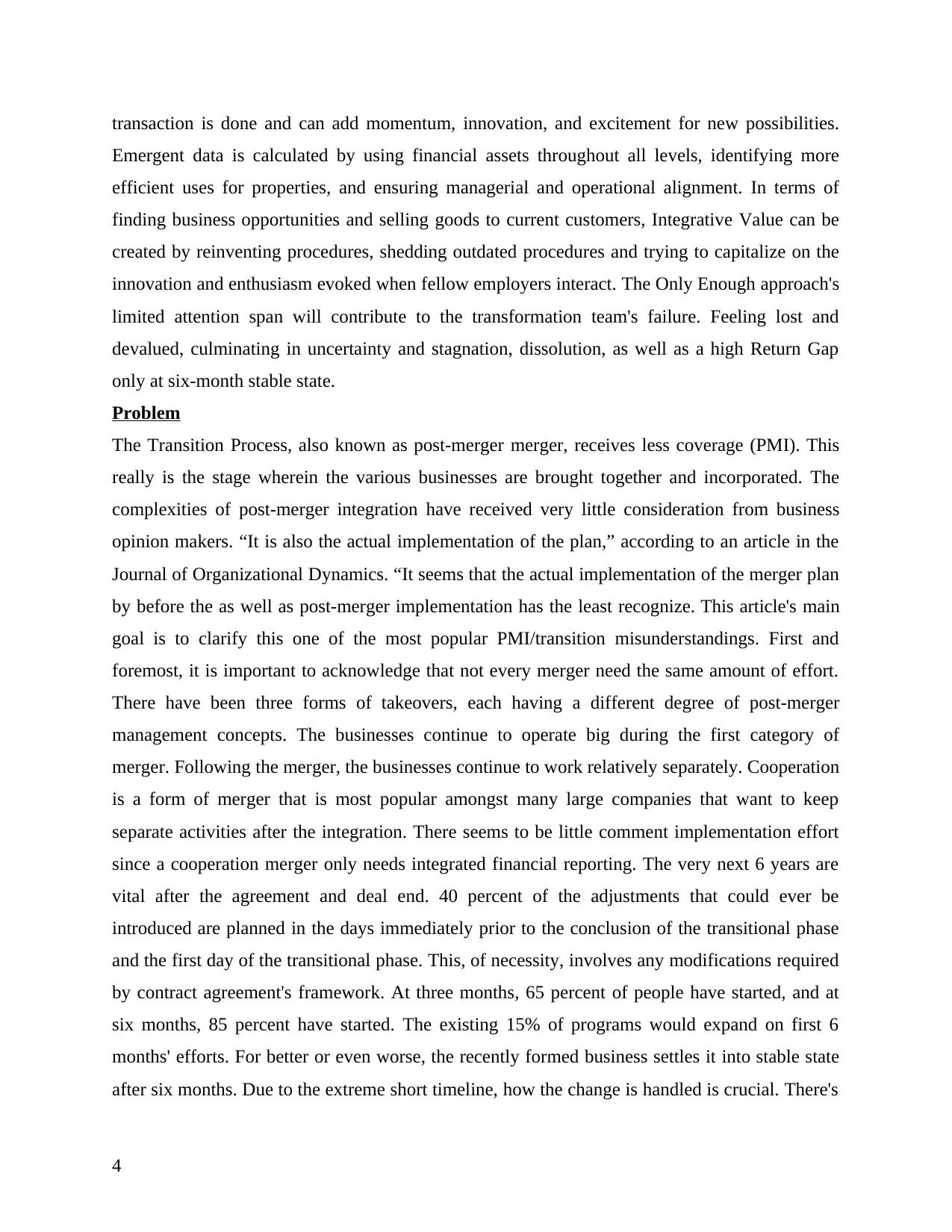
transaction is done and can add momentum, innovation, and excitement for new possibilities.
Emergent data is calculated by using financial assets throughout all levels, identifying more
efficient uses for properties, and ensuring managerial and operational alignment. In terms of
finding business opportunities and selling goods to current customers, Integrative Value can be
created by reinventing procedures, shedding outdated procedures and trying to capitalize on the
innovation and enthusiasm evoked when fellow employers interact. The Only Enough approach's
limited attention span will contribute to the transformation team's failure. Feeling lost and
devalued, culminating in uncertainty and stagnation, dissolution, as well as a high Return Gap
only at six-month stable state.
Problem
The Transition Process, also known as post-merger merger, receives less coverage (PMI). This
really is the stage wherein the various businesses are brought together and incorporated. The
complexities of post-merger integration have received very little consideration from business
opinion makers. “It is also the actual implementation of the plan,” according to an article in the
Journal of Organizational Dynamics. “It seems that the actual implementation of the merger plan
by before the as well as post-merger implementation has the least recognize. This article's main
goal is to clarify this one of the most popular PMI/transition misunderstandings. First and
foremost, it is important to acknowledge that not every merger need the same amount of effort.
There have been three forms of takeovers, each having a different degree of post-merger
management concepts. The businesses continue to operate big during the first category of
merger. Following the merger, the businesses continue to work relatively separately. Cooperation
is a form of merger that is most popular amongst many large companies that want to keep
separate activities after the integration. There seems to be little comment implementation effort
since a cooperation merger only needs integrated financial reporting. The very next 6 years are
vital after the agreement and deal end. 40 percent of the adjustments that could ever be
introduced are planned in the days immediately prior to the conclusion of the transitional phase
and the first day of the transitional phase. This, of necessity, involves any modifications required
by contract agreement's framework. At three months, 65 percent of people have started, and at
six months, 85 percent have started. The existing 15% of programs would expand on first 6
months' efforts. For better or even worse, the recently formed business settles it into stable state
after six months. Due to the extreme short timeline, how the change is handled is crucial. There's
4
Emergent data is calculated by using financial assets throughout all levels, identifying more
efficient uses for properties, and ensuring managerial and operational alignment. In terms of
finding business opportunities and selling goods to current customers, Integrative Value can be
created by reinventing procedures, shedding outdated procedures and trying to capitalize on the
innovation and enthusiasm evoked when fellow employers interact. The Only Enough approach's
limited attention span will contribute to the transformation team's failure. Feeling lost and
devalued, culminating in uncertainty and stagnation, dissolution, as well as a high Return Gap
only at six-month stable state.
Problem
The Transition Process, also known as post-merger merger, receives less coverage (PMI). This
really is the stage wherein the various businesses are brought together and incorporated. The
complexities of post-merger integration have received very little consideration from business
opinion makers. “It is also the actual implementation of the plan,” according to an article in the
Journal of Organizational Dynamics. “It seems that the actual implementation of the merger plan
by before the as well as post-merger implementation has the least recognize. This article's main
goal is to clarify this one of the most popular PMI/transition misunderstandings. First and
foremost, it is important to acknowledge that not every merger need the same amount of effort.
There have been three forms of takeovers, each having a different degree of post-merger
management concepts. The businesses continue to operate big during the first category of
merger. Following the merger, the businesses continue to work relatively separately. Cooperation
is a form of merger that is most popular amongst many large companies that want to keep
separate activities after the integration. There seems to be little comment implementation effort
since a cooperation merger only needs integrated financial reporting. The very next 6 years are
vital after the agreement and deal end. 40 percent of the adjustments that could ever be
introduced are planned in the days immediately prior to the conclusion of the transitional phase
and the first day of the transitional phase. This, of necessity, involves any modifications required
by contract agreement's framework. At three months, 65 percent of people have started, and at
six months, 85 percent have started. The existing 15% of programs would expand on first 6
months' efforts. For better or even worse, the recently formed business settles it into stable state
after six months. Due to the extreme short timeline, how the change is handled is crucial. There's
4
Paraphrase This Document
Need a fresh take? Get an instant paraphrase of this document with our AI Paraphraser
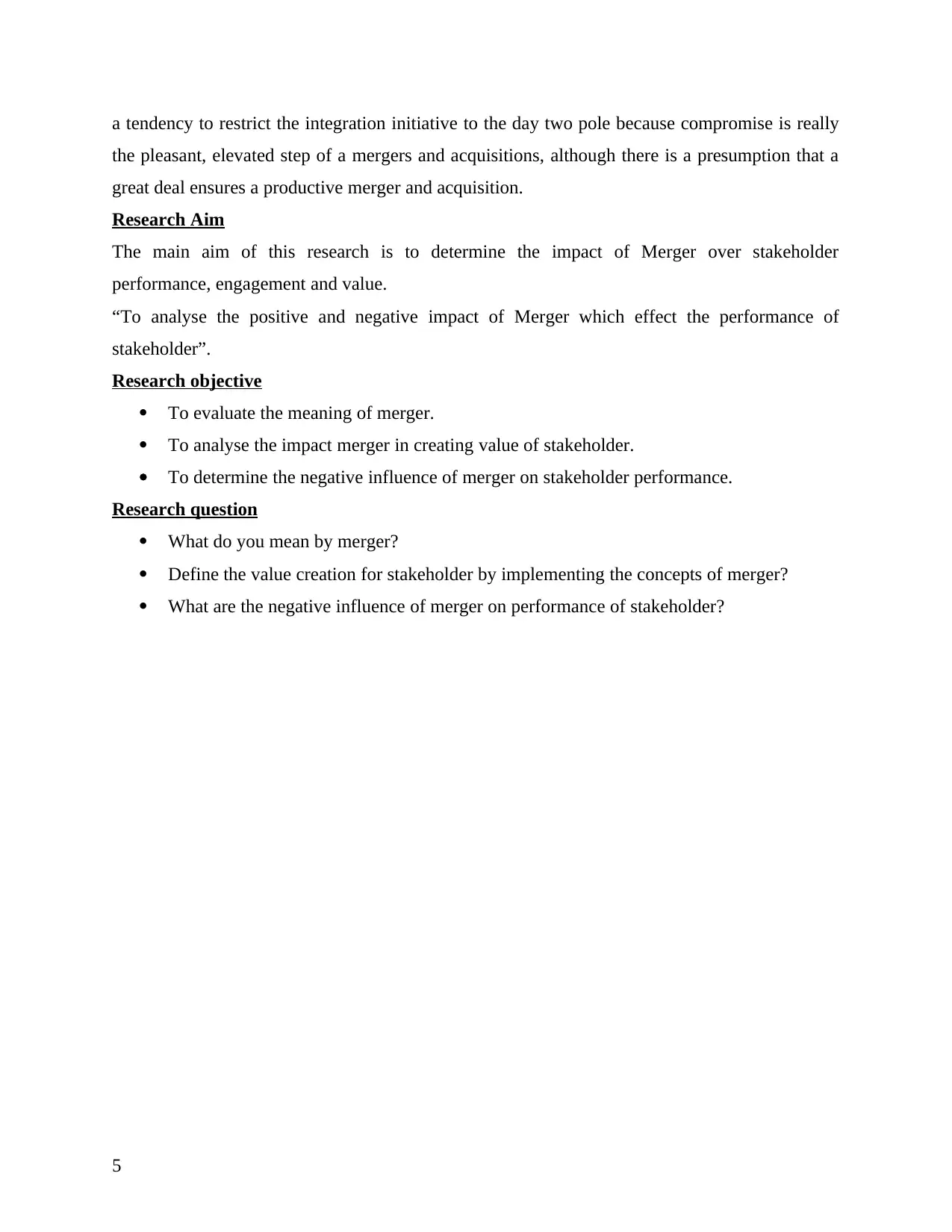
a tendency to restrict the integration initiative to the day two pole because compromise is really
the pleasant, elevated step of a mergers and acquisitions, although there is a presumption that a
great deal ensures a productive merger and acquisition.
Research Aim
The main aim of this research is to determine the impact of Merger over stakeholder
performance, engagement and value.
“To analyse the positive and negative impact of Merger which effect the performance of
stakeholder”.
Research objective
To evaluate the meaning of merger.
To analyse the impact merger in creating value of stakeholder.
To determine the negative influence of merger on stakeholder performance.
Research question
What do you mean by merger?
Define the value creation for stakeholder by implementing the concepts of merger?
What are the negative influence of merger on performance of stakeholder?
5
the pleasant, elevated step of a mergers and acquisitions, although there is a presumption that a
great deal ensures a productive merger and acquisition.
Research Aim
The main aim of this research is to determine the impact of Merger over stakeholder
performance, engagement and value.
“To analyse the positive and negative impact of Merger which effect the performance of
stakeholder”.
Research objective
To evaluate the meaning of merger.
To analyse the impact merger in creating value of stakeholder.
To determine the negative influence of merger on stakeholder performance.
Research question
What do you mean by merger?
Define the value creation for stakeholder by implementing the concepts of merger?
What are the negative influence of merger on performance of stakeholder?
5
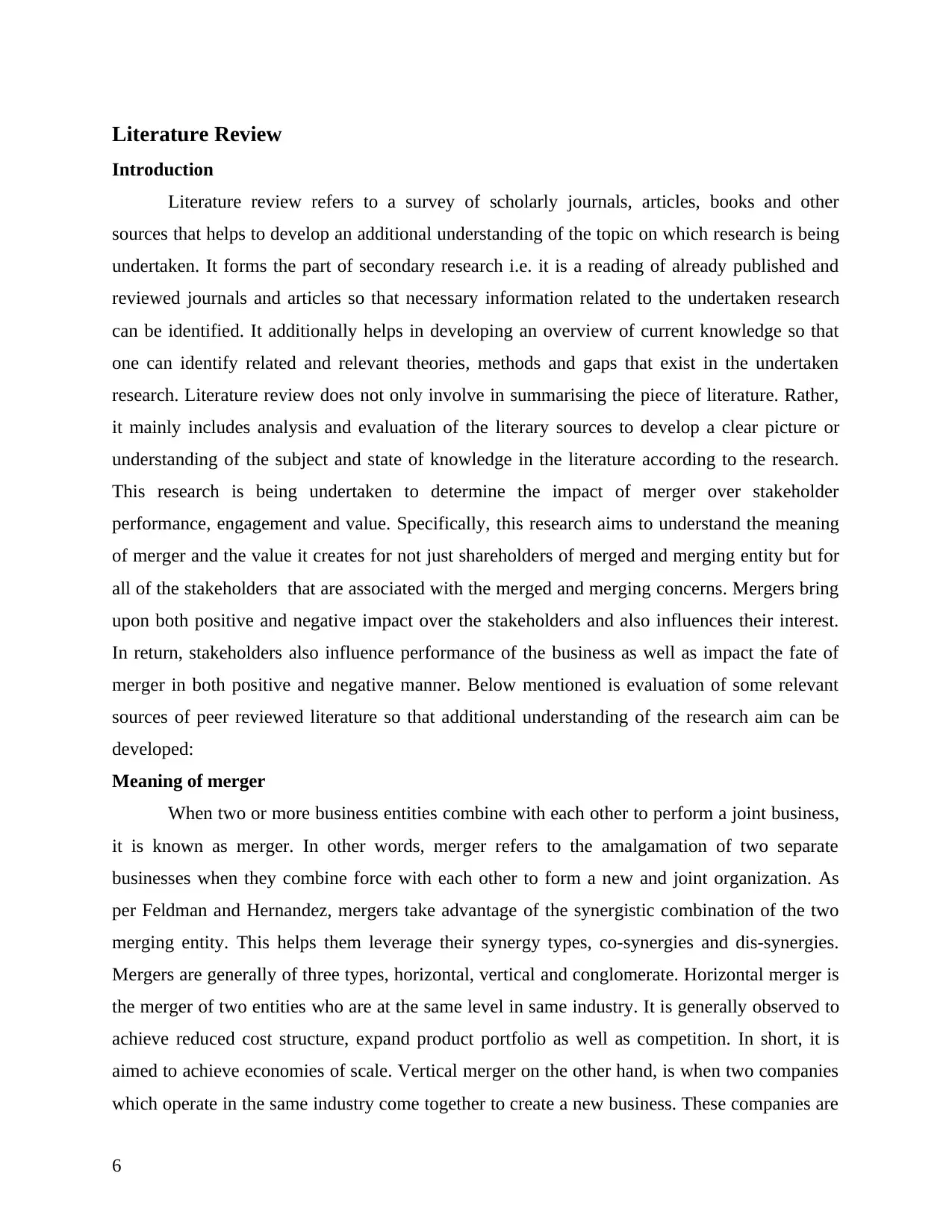
Literature Review
Introduction
Literature review refers to a survey of scholarly journals, articles, books and other
sources that helps to develop an additional understanding of the topic on which research is being
undertaken. It forms the part of secondary research i.e. it is a reading of already published and
reviewed journals and articles so that necessary information related to the undertaken research
can be identified. It additionally helps in developing an overview of current knowledge so that
one can identify related and relevant theories, methods and gaps that exist in the undertaken
research. Literature review does not only involve in summarising the piece of literature. Rather,
it mainly includes analysis and evaluation of the literary sources to develop a clear picture or
understanding of the subject and state of knowledge in the literature according to the research.
This research is being undertaken to determine the impact of merger over stakeholder
performance, engagement and value. Specifically, this research aims to understand the meaning
of merger and the value it creates for not just shareholders of merged and merging entity but for
all of the stakeholders that are associated with the merged and merging concerns. Mergers bring
upon both positive and negative impact over the stakeholders and also influences their interest.
In return, stakeholders also influence performance of the business as well as impact the fate of
merger in both positive and negative manner. Below mentioned is evaluation of some relevant
sources of peer reviewed literature so that additional understanding of the research aim can be
developed:
Meaning of merger
When two or more business entities combine with each other to perform a joint business,
it is known as merger. In other words, merger refers to the amalgamation of two separate
businesses when they combine force with each other to form a new and joint organization. As
per Feldman and Hernandez, mergers take advantage of the synergistic combination of the two
merging entity. This helps them leverage their synergy types, co-synergies and dis-synergies.
Mergers are generally of three types, horizontal, vertical and conglomerate. Horizontal merger is
the merger of two entities who are at the same level in same industry. It is generally observed to
achieve reduced cost structure, expand product portfolio as well as competition. In short, it is
aimed to achieve economies of scale. Vertical merger on the other hand, is when two companies
which operate in the same industry come together to create a new business. These companies are
6
Introduction
Literature review refers to a survey of scholarly journals, articles, books and other
sources that helps to develop an additional understanding of the topic on which research is being
undertaken. It forms the part of secondary research i.e. it is a reading of already published and
reviewed journals and articles so that necessary information related to the undertaken research
can be identified. It additionally helps in developing an overview of current knowledge so that
one can identify related and relevant theories, methods and gaps that exist in the undertaken
research. Literature review does not only involve in summarising the piece of literature. Rather,
it mainly includes analysis and evaluation of the literary sources to develop a clear picture or
understanding of the subject and state of knowledge in the literature according to the research.
This research is being undertaken to determine the impact of merger over stakeholder
performance, engagement and value. Specifically, this research aims to understand the meaning
of merger and the value it creates for not just shareholders of merged and merging entity but for
all of the stakeholders that are associated with the merged and merging concerns. Mergers bring
upon both positive and negative impact over the stakeholders and also influences their interest.
In return, stakeholders also influence performance of the business as well as impact the fate of
merger in both positive and negative manner. Below mentioned is evaluation of some relevant
sources of peer reviewed literature so that additional understanding of the research aim can be
developed:
Meaning of merger
When two or more business entities combine with each other to perform a joint business,
it is known as merger. In other words, merger refers to the amalgamation of two separate
businesses when they combine force with each other to form a new and joint organization. As
per Feldman and Hernandez, mergers take advantage of the synergistic combination of the two
merging entity. This helps them leverage their synergy types, co-synergies and dis-synergies.
Mergers are generally of three types, horizontal, vertical and conglomerate. Horizontal merger is
the merger of two entities who are at the same level in same industry. It is generally observed to
achieve reduced cost structure, expand product portfolio as well as competition. In short, it is
aimed to achieve economies of scale. Vertical merger on the other hand, is when two companies
which operate in the same industry come together to create a new business. These companies are
6
⊘ This is a preview!⊘
Do you want full access?
Subscribe today to unlock all pages.

Trusted by 1+ million students worldwide
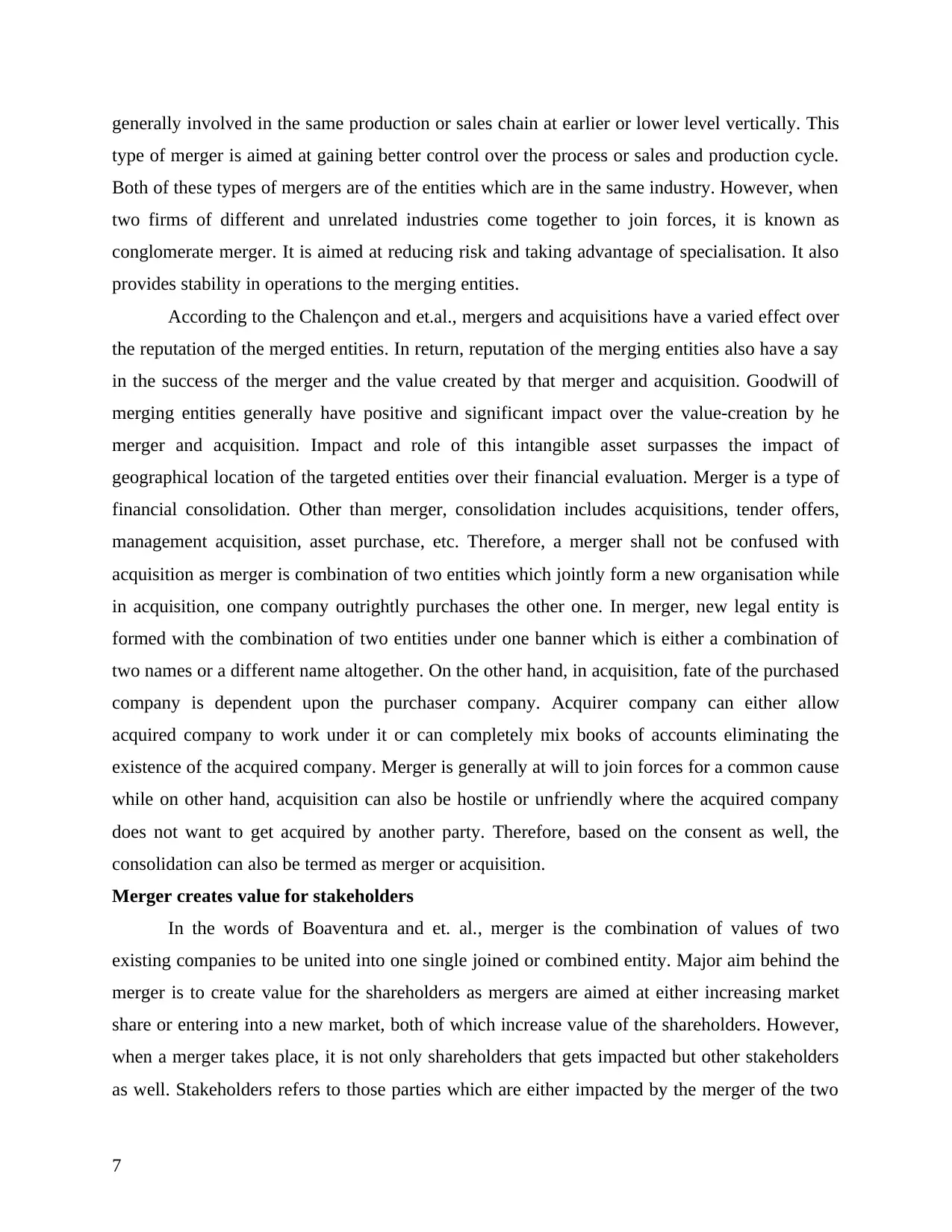
generally involved in the same production or sales chain at earlier or lower level vertically. This
type of merger is aimed at gaining better control over the process or sales and production cycle.
Both of these types of mergers are of the entities which are in the same industry. However, when
two firms of different and unrelated industries come together to join forces, it is known as
conglomerate merger. It is aimed at reducing risk and taking advantage of specialisation. It also
provides stability in operations to the merging entities.
According to the Chalençon and et.al., mergers and acquisitions have a varied effect over
the reputation of the merged entities. In return, reputation of the merging entities also have a say
in the success of the merger and the value created by that merger and acquisition. Goodwill of
merging entities generally have positive and significant impact over the value-creation by he
merger and acquisition. Impact and role of this intangible asset surpasses the impact of
geographical location of the targeted entities over their financial evaluation. Merger is a type of
financial consolidation. Other than merger, consolidation includes acquisitions, tender offers,
management acquisition, asset purchase, etc. Therefore, a merger shall not be confused with
acquisition as merger is combination of two entities which jointly form a new organisation while
in acquisition, one company outrightly purchases the other one. In merger, new legal entity is
formed with the combination of two entities under one banner which is either a combination of
two names or a different name altogether. On the other hand, in acquisition, fate of the purchased
company is dependent upon the purchaser company. Acquirer company can either allow
acquired company to work under it or can completely mix books of accounts eliminating the
existence of the acquired company. Merger is generally at will to join forces for a common cause
while on other hand, acquisition can also be hostile or unfriendly where the acquired company
does not want to get acquired by another party. Therefore, based on the consent as well, the
consolidation can also be termed as merger or acquisition.
Merger creates value for stakeholders
In the words of Boaventura and et. al., merger is the combination of values of two
existing companies to be united into one single joined or combined entity. Major aim behind the
merger is to create value for the shareholders as mergers are aimed at either increasing market
share or entering into a new market, both of which increase value of the shareholders. However,
when a merger takes place, it is not only shareholders that gets impacted but other stakeholders
as well. Stakeholders refers to those parties which are either impacted by the merger of the two
7
type of merger is aimed at gaining better control over the process or sales and production cycle.
Both of these types of mergers are of the entities which are in the same industry. However, when
two firms of different and unrelated industries come together to join forces, it is known as
conglomerate merger. It is aimed at reducing risk and taking advantage of specialisation. It also
provides stability in operations to the merging entities.
According to the Chalençon and et.al., mergers and acquisitions have a varied effect over
the reputation of the merged entities. In return, reputation of the merging entities also have a say
in the success of the merger and the value created by that merger and acquisition. Goodwill of
merging entities generally have positive and significant impact over the value-creation by he
merger and acquisition. Impact and role of this intangible asset surpasses the impact of
geographical location of the targeted entities over their financial evaluation. Merger is a type of
financial consolidation. Other than merger, consolidation includes acquisitions, tender offers,
management acquisition, asset purchase, etc. Therefore, a merger shall not be confused with
acquisition as merger is combination of two entities which jointly form a new organisation while
in acquisition, one company outrightly purchases the other one. In merger, new legal entity is
formed with the combination of two entities under one banner which is either a combination of
two names or a different name altogether. On the other hand, in acquisition, fate of the purchased
company is dependent upon the purchaser company. Acquirer company can either allow
acquired company to work under it or can completely mix books of accounts eliminating the
existence of the acquired company. Merger is generally at will to join forces for a common cause
while on other hand, acquisition can also be hostile or unfriendly where the acquired company
does not want to get acquired by another party. Therefore, based on the consent as well, the
consolidation can also be termed as merger or acquisition.
Merger creates value for stakeholders
In the words of Boaventura and et. al., merger is the combination of values of two
existing companies to be united into one single joined or combined entity. Major aim behind the
merger is to create value for the shareholders as mergers are aimed at either increasing market
share or entering into a new market, both of which increase value of the shareholders. However,
when a merger takes place, it is not only shareholders that gets impacted but other stakeholders
as well. Stakeholders refers to those parties which are either impacted by the merger of the two
7
Paraphrase This Document
Need a fresh take? Get an instant paraphrase of this document with our AI Paraphraser
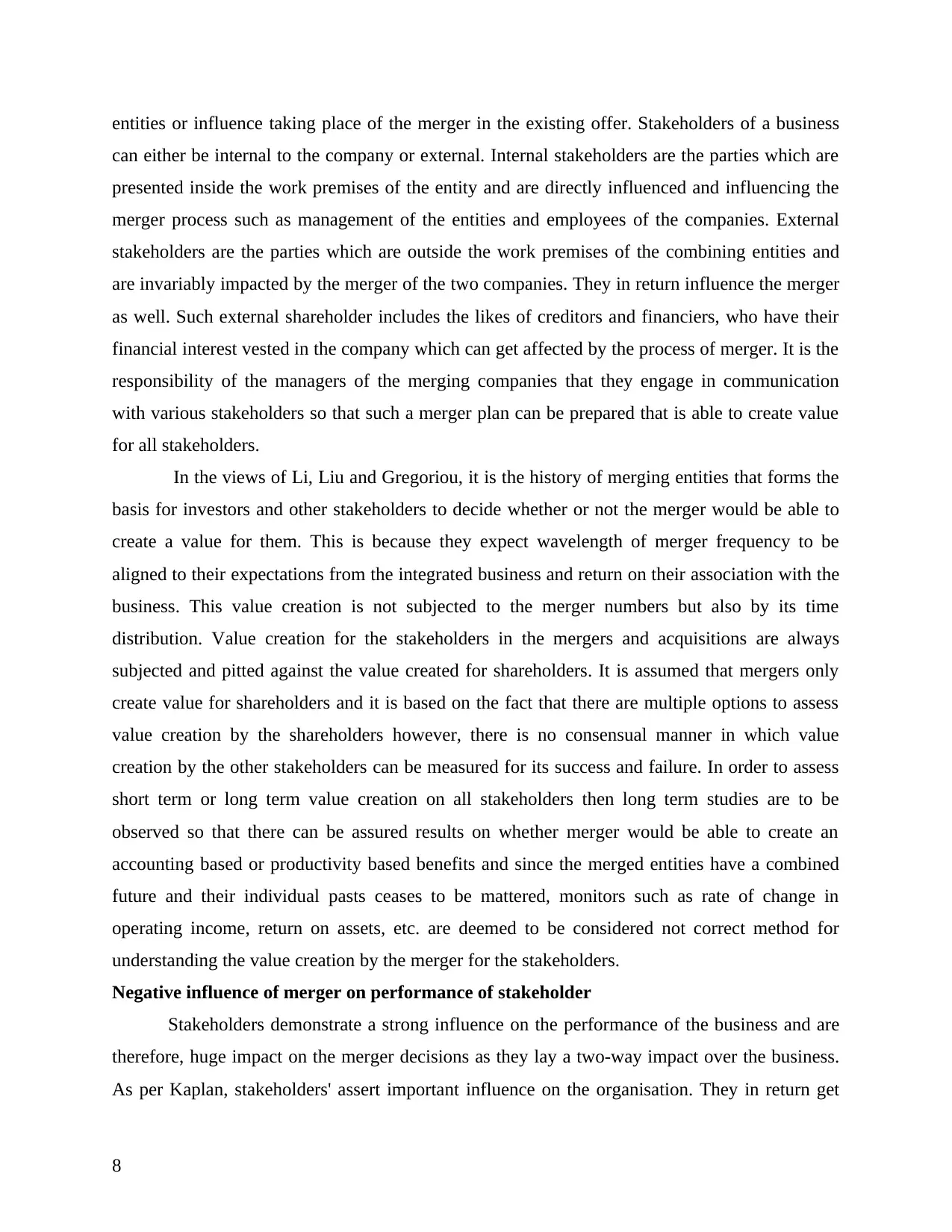
entities or influence taking place of the merger in the existing offer. Stakeholders of a business
can either be internal to the company or external. Internal stakeholders are the parties which are
presented inside the work premises of the entity and are directly influenced and influencing the
merger process such as management of the entities and employees of the companies. External
stakeholders are the parties which are outside the work premises of the combining entities and
are invariably impacted by the merger of the two companies. They in return influence the merger
as well. Such external shareholder includes the likes of creditors and financiers, who have their
financial interest vested in the company which can get affected by the process of merger. It is the
responsibility of the managers of the merging companies that they engage in communication
with various stakeholders so that such a merger plan can be prepared that is able to create value
for all stakeholders.
In the views of Li, Liu and Gregoriou, it is the history of merging entities that forms the
basis for investors and other stakeholders to decide whether or not the merger would be able to
create a value for them. This is because they expect wavelength of merger frequency to be
aligned to their expectations from the integrated business and return on their association with the
business. This value creation is not subjected to the merger numbers but also by its time
distribution. Value creation for the stakeholders in the mergers and acquisitions are always
subjected and pitted against the value created for shareholders. It is assumed that mergers only
create value for shareholders and it is based on the fact that there are multiple options to assess
value creation by the shareholders however, there is no consensual manner in which value
creation by the other stakeholders can be measured for its success and failure. In order to assess
short term or long term value creation on all stakeholders then long term studies are to be
observed so that there can be assured results on whether merger would be able to create an
accounting based or productivity based benefits and since the merged entities have a combined
future and their individual pasts ceases to be mattered, monitors such as rate of change in
operating income, return on assets, etc. are deemed to be considered not correct method for
understanding the value creation by the merger for the stakeholders.
Negative influence of merger on performance of stakeholder
Stakeholders demonstrate a strong influence on the performance of the business and are
therefore, huge impact on the merger decisions as they lay a two-way impact over the business.
As per Kaplan, stakeholders' assert important influence on the organisation. They in return get
8
can either be internal to the company or external. Internal stakeholders are the parties which are
presented inside the work premises of the entity and are directly influenced and influencing the
merger process such as management of the entities and employees of the companies. External
stakeholders are the parties which are outside the work premises of the combining entities and
are invariably impacted by the merger of the two companies. They in return influence the merger
as well. Such external shareholder includes the likes of creditors and financiers, who have their
financial interest vested in the company which can get affected by the process of merger. It is the
responsibility of the managers of the merging companies that they engage in communication
with various stakeholders so that such a merger plan can be prepared that is able to create value
for all stakeholders.
In the views of Li, Liu and Gregoriou, it is the history of merging entities that forms the
basis for investors and other stakeholders to decide whether or not the merger would be able to
create a value for them. This is because they expect wavelength of merger frequency to be
aligned to their expectations from the integrated business and return on their association with the
business. This value creation is not subjected to the merger numbers but also by its time
distribution. Value creation for the stakeholders in the mergers and acquisitions are always
subjected and pitted against the value created for shareholders. It is assumed that mergers only
create value for shareholders and it is based on the fact that there are multiple options to assess
value creation by the shareholders however, there is no consensual manner in which value
creation by the other stakeholders can be measured for its success and failure. In order to assess
short term or long term value creation on all stakeholders then long term studies are to be
observed so that there can be assured results on whether merger would be able to create an
accounting based or productivity based benefits and since the merged entities have a combined
future and their individual pasts ceases to be mattered, monitors such as rate of change in
operating income, return on assets, etc. are deemed to be considered not correct method for
understanding the value creation by the merger for the stakeholders.
Negative influence of merger on performance of stakeholder
Stakeholders demonstrate a strong influence on the performance of the business and are
therefore, huge impact on the merger decisions as they lay a two-way impact over the business.
As per Kaplan, stakeholders' assert important influence on the organisation. They in return get
8
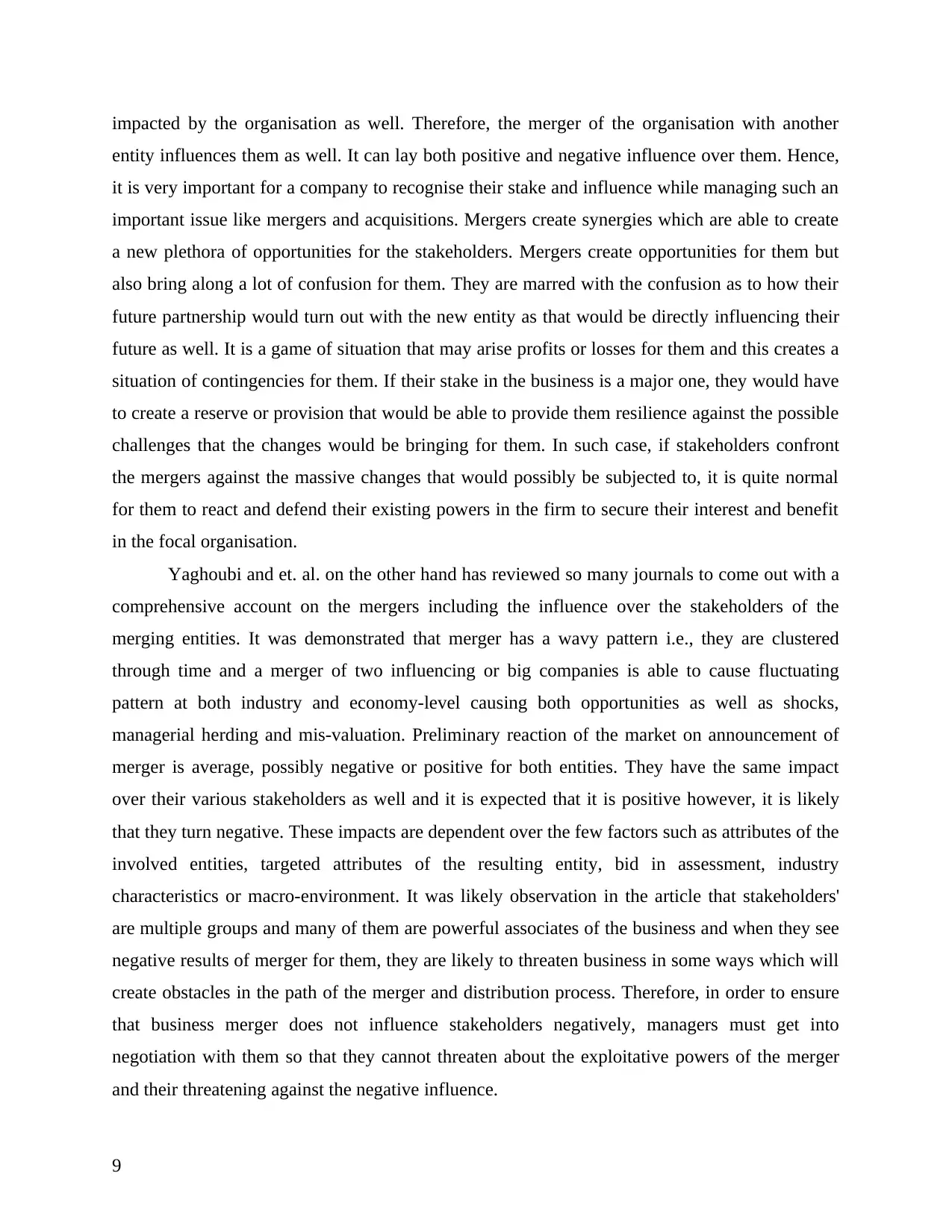
impacted by the organisation as well. Therefore, the merger of the organisation with another
entity influences them as well. It can lay both positive and negative influence over them. Hence,
it is very important for a company to recognise their stake and influence while managing such an
important issue like mergers and acquisitions. Mergers create synergies which are able to create
a new plethora of opportunities for the stakeholders. Mergers create opportunities for them but
also bring along a lot of confusion for them. They are marred with the confusion as to how their
future partnership would turn out with the new entity as that would be directly influencing their
future as well. It is a game of situation that may arise profits or losses for them and this creates a
situation of contingencies for them. If their stake in the business is a major one, they would have
to create a reserve or provision that would be able to provide them resilience against the possible
challenges that the changes would be bringing for them. In such case, if stakeholders confront
the mergers against the massive changes that would possibly be subjected to, it is quite normal
for them to react and defend their existing powers in the firm to secure their interest and benefit
in the focal organisation.
Yaghoubi and et. al. on the other hand has reviewed so many journals to come out with a
comprehensive account on the mergers including the influence over the stakeholders of the
merging entities. It was demonstrated that merger has a wavy pattern i.e., they are clustered
through time and a merger of two influencing or big companies is able to cause fluctuating
pattern at both industry and economy-level causing both opportunities as well as shocks,
managerial herding and mis-valuation. Preliminary reaction of the market on announcement of
merger is average, possibly negative or positive for both entities. They have the same impact
over their various stakeholders as well and it is expected that it is positive however, it is likely
that they turn negative. These impacts are dependent over the few factors such as attributes of the
involved entities, targeted attributes of the resulting entity, bid in assessment, industry
characteristics or macro-environment. It was likely observation in the article that stakeholders'
are multiple groups and many of them are powerful associates of the business and when they see
negative results of merger for them, they are likely to threaten business in some ways which will
create obstacles in the path of the merger and distribution process. Therefore, in order to ensure
that business merger does not influence stakeholders negatively, managers must get into
negotiation with them so that they cannot threaten about the exploitative powers of the merger
and their threatening against the negative influence.
9
entity influences them as well. It can lay both positive and negative influence over them. Hence,
it is very important for a company to recognise their stake and influence while managing such an
important issue like mergers and acquisitions. Mergers create synergies which are able to create
a new plethora of opportunities for the stakeholders. Mergers create opportunities for them but
also bring along a lot of confusion for them. They are marred with the confusion as to how their
future partnership would turn out with the new entity as that would be directly influencing their
future as well. It is a game of situation that may arise profits or losses for them and this creates a
situation of contingencies for them. If their stake in the business is a major one, they would have
to create a reserve or provision that would be able to provide them resilience against the possible
challenges that the changes would be bringing for them. In such case, if stakeholders confront
the mergers against the massive changes that would possibly be subjected to, it is quite normal
for them to react and defend their existing powers in the firm to secure their interest and benefit
in the focal organisation.
Yaghoubi and et. al. on the other hand has reviewed so many journals to come out with a
comprehensive account on the mergers including the influence over the stakeholders of the
merging entities. It was demonstrated that merger has a wavy pattern i.e., they are clustered
through time and a merger of two influencing or big companies is able to cause fluctuating
pattern at both industry and economy-level causing both opportunities as well as shocks,
managerial herding and mis-valuation. Preliminary reaction of the market on announcement of
merger is average, possibly negative or positive for both entities. They have the same impact
over their various stakeholders as well and it is expected that it is positive however, it is likely
that they turn negative. These impacts are dependent over the few factors such as attributes of the
involved entities, targeted attributes of the resulting entity, bid in assessment, industry
characteristics or macro-environment. It was likely observation in the article that stakeholders'
are multiple groups and many of them are powerful associates of the business and when they see
negative results of merger for them, they are likely to threaten business in some ways which will
create obstacles in the path of the merger and distribution process. Therefore, in order to ensure
that business merger does not influence stakeholders negatively, managers must get into
negotiation with them so that they cannot threaten about the exploitative powers of the merger
and their threatening against the negative influence.
9
⊘ This is a preview!⊘
Do you want full access?
Subscribe today to unlock all pages.

Trusted by 1+ million students worldwide
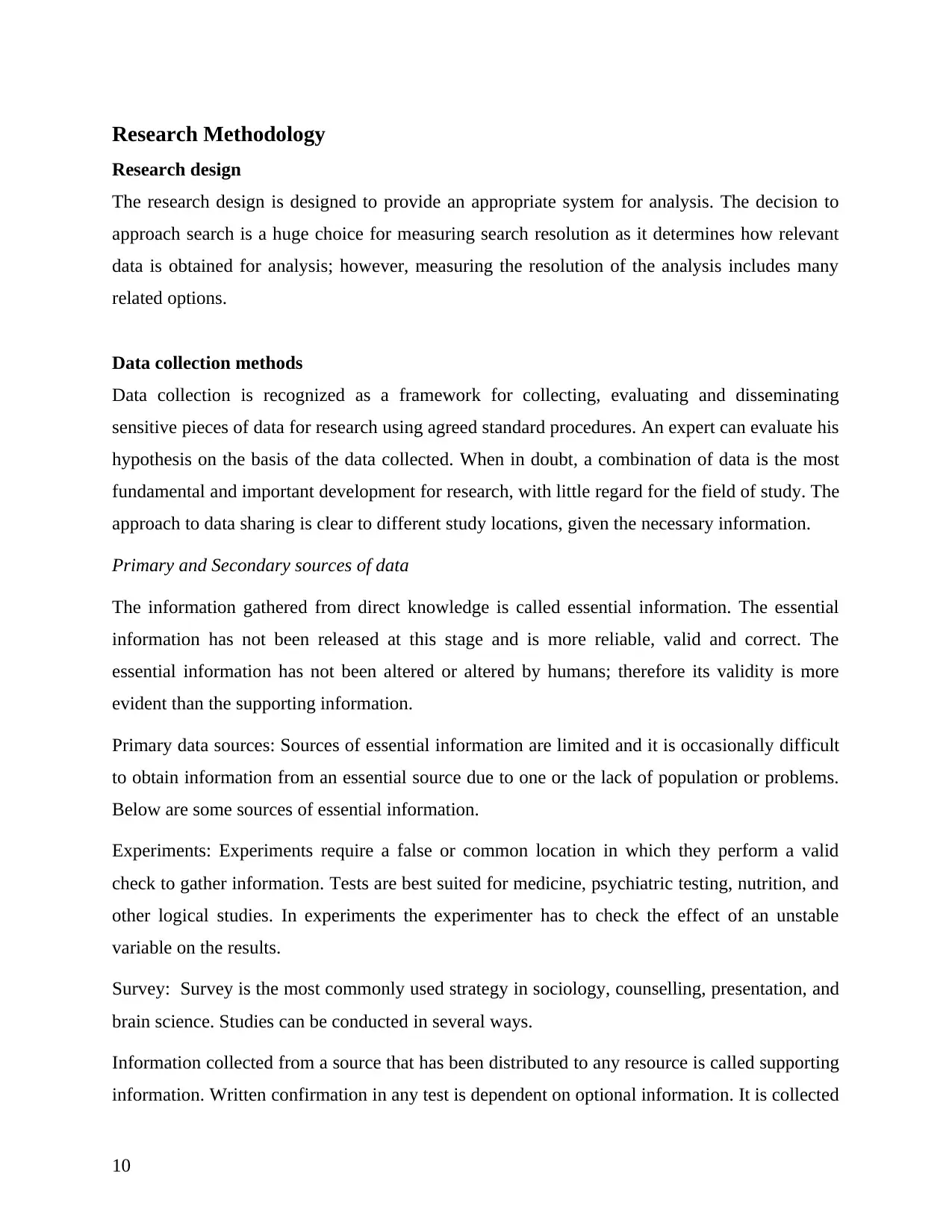
Research Methodology
Research design
The research design is designed to provide an appropriate system for analysis. The decision to
approach search is a huge choice for measuring search resolution as it determines how relevant
data is obtained for analysis; however, measuring the resolution of the analysis includes many
related options.
Data collection methods
Data collection is recognized as a framework for collecting, evaluating and disseminating
sensitive pieces of data for research using agreed standard procedures. An expert can evaluate his
hypothesis on the basis of the data collected. When in doubt, a combination of data is the most
fundamental and important development for research, with little regard for the field of study. The
approach to data sharing is clear to different study locations, given the necessary information.
Primary and Secondary sources of data
The information gathered from direct knowledge is called essential information. The essential
information has not been released at this stage and is more reliable, valid and correct. The
essential information has not been altered or altered by humans; therefore its validity is more
evident than the supporting information.
Primary data sources: Sources of essential information are limited and it is occasionally difficult
to obtain information from an essential source due to one or the lack of population or problems.
Below are some sources of essential information.
Experiments: Experiments require a false or common location in which they perform a valid
check to gather information. Tests are best suited for medicine, psychiatric testing, nutrition, and
other logical studies. In experiments the experimenter has to check the effect of an unstable
variable on the results.
Survey: Survey is the most commonly used strategy in sociology, counselling, presentation, and
brain science. Studies can be conducted in several ways.
Information collected from a source that has been distributed to any resource is called supporting
information. Written confirmation in any test is dependent on optional information. It is collected
10
Research design
The research design is designed to provide an appropriate system for analysis. The decision to
approach search is a huge choice for measuring search resolution as it determines how relevant
data is obtained for analysis; however, measuring the resolution of the analysis includes many
related options.
Data collection methods
Data collection is recognized as a framework for collecting, evaluating and disseminating
sensitive pieces of data for research using agreed standard procedures. An expert can evaluate his
hypothesis on the basis of the data collected. When in doubt, a combination of data is the most
fundamental and important development for research, with little regard for the field of study. The
approach to data sharing is clear to different study locations, given the necessary information.
Primary and Secondary sources of data
The information gathered from direct knowledge is called essential information. The essential
information has not been released at this stage and is more reliable, valid and correct. The
essential information has not been altered or altered by humans; therefore its validity is more
evident than the supporting information.
Primary data sources: Sources of essential information are limited and it is occasionally difficult
to obtain information from an essential source due to one or the lack of population or problems.
Below are some sources of essential information.
Experiments: Experiments require a false or common location in which they perform a valid
check to gather information. Tests are best suited for medicine, psychiatric testing, nutrition, and
other logical studies. In experiments the experimenter has to check the effect of an unstable
variable on the results.
Survey: Survey is the most commonly used strategy in sociology, counselling, presentation, and
brain science. Studies can be conducted in several ways.
Information collected from a source that has been distributed to any resource is called supporting
information. Written confirmation in any test is dependent on optional information. It is collected
10
Paraphrase This Document
Need a fresh take? Get an instant paraphrase of this document with our AI Paraphraser
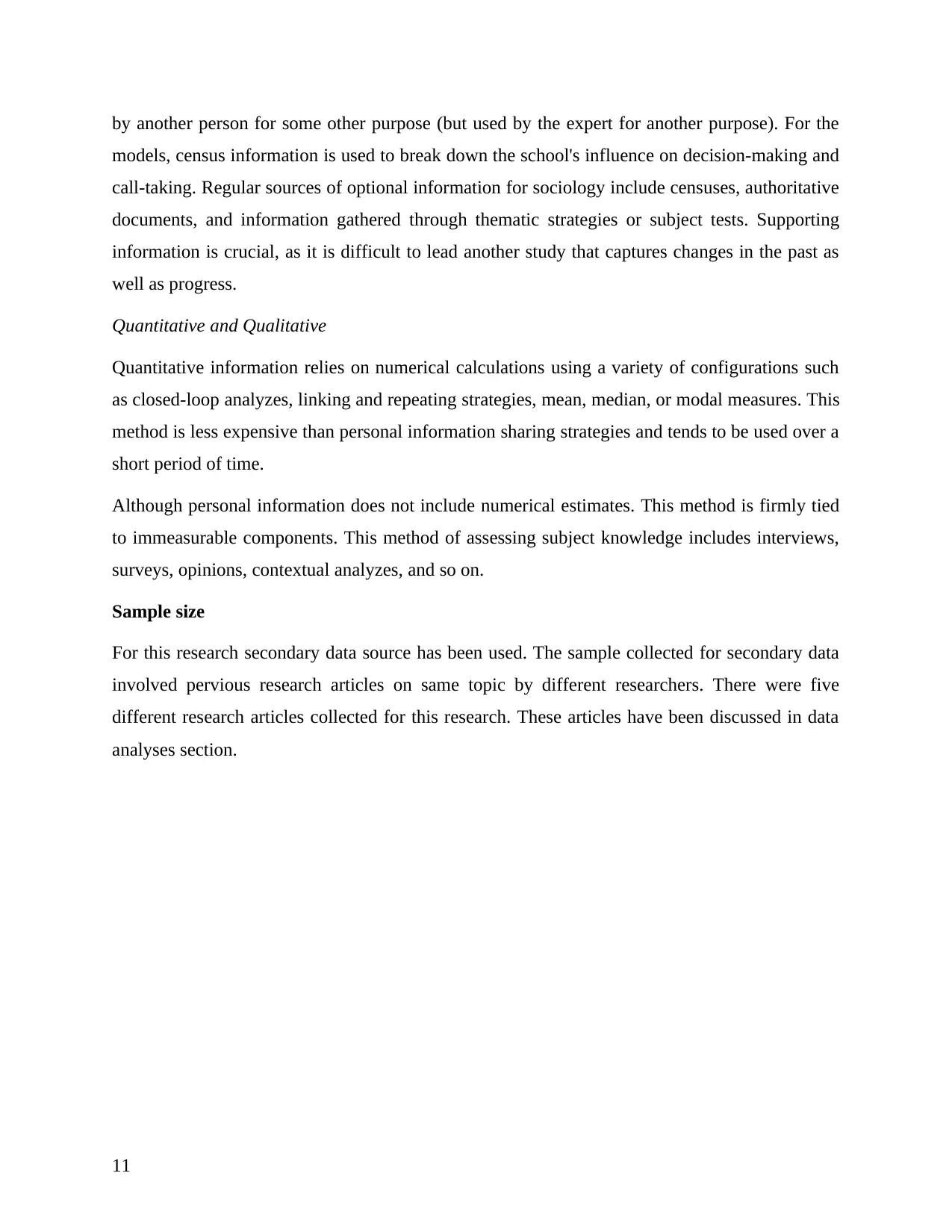
by another person for some other purpose (but used by the expert for another purpose). For the
models, census information is used to break down the school's influence on decision-making and
call-taking. Regular sources of optional information for sociology include censuses, authoritative
documents, and information gathered through thematic strategies or subject tests. Supporting
information is crucial, as it is difficult to lead another study that captures changes in the past as
well as progress.
Quantitative and Qualitative
Quantitative information relies on numerical calculations using a variety of configurations such
as closed-loop analyzes, linking and repeating strategies, mean, median, or modal measures. This
method is less expensive than personal information sharing strategies and tends to be used over a
short period of time.
Although personal information does not include numerical estimates. This method is firmly tied
to immeasurable components. This method of assessing subject knowledge includes interviews,
surveys, opinions, contextual analyzes, and so on.
Sample size
For this research secondary data source has been used. The sample collected for secondary data
involved pervious research articles on same topic by different researchers. There were five
different research articles collected for this research. These articles have been discussed in data
analyses section.
11
models, census information is used to break down the school's influence on decision-making and
call-taking. Regular sources of optional information for sociology include censuses, authoritative
documents, and information gathered through thematic strategies or subject tests. Supporting
information is crucial, as it is difficult to lead another study that captures changes in the past as
well as progress.
Quantitative and Qualitative
Quantitative information relies on numerical calculations using a variety of configurations such
as closed-loop analyzes, linking and repeating strategies, mean, median, or modal measures. This
method is less expensive than personal information sharing strategies and tends to be used over a
short period of time.
Although personal information does not include numerical estimates. This method is firmly tied
to immeasurable components. This method of assessing subject knowledge includes interviews,
surveys, opinions, contextual analyzes, and so on.
Sample size
For this research secondary data source has been used. The sample collected for secondary data
involved pervious research articles on same topic by different researchers. There were five
different research articles collected for this research. These articles have been discussed in data
analyses section.
11
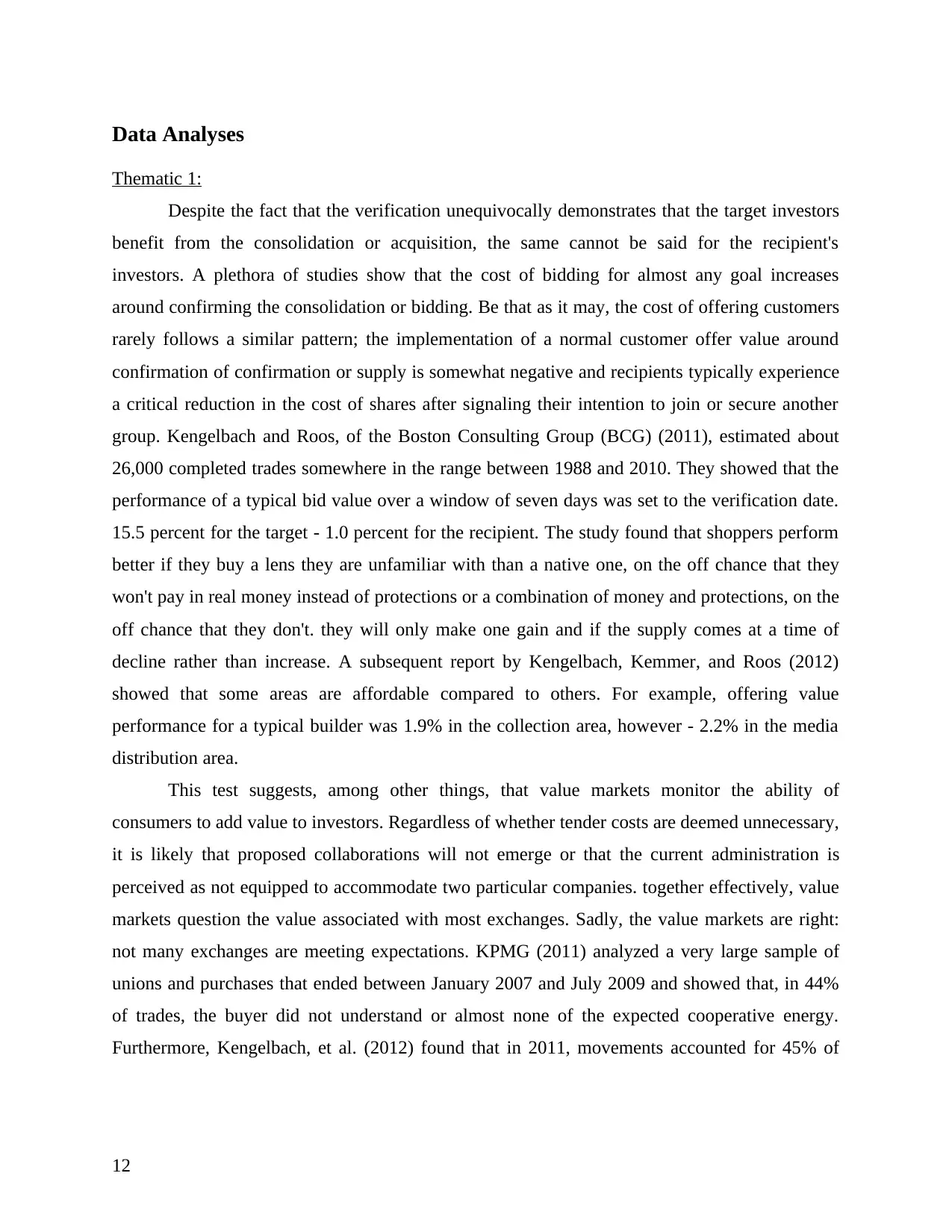
Data Analyses
Thematic 1:
Despite the fact that the verification unequivocally demonstrates that the target investors
benefit from the consolidation or acquisition, the same cannot be said for the recipient's
investors. A plethora of studies show that the cost of bidding for almost any goal increases
around confirming the consolidation or bidding. Be that as it may, the cost of offering customers
rarely follows a similar pattern; the implementation of a normal customer offer value around
confirmation of confirmation or supply is somewhat negative and recipients typically experience
a critical reduction in the cost of shares after signaling their intention to join or secure another
group. Kengelbach and Roos, of the Boston Consulting Group (BCG) (2011), estimated about
26,000 completed trades somewhere in the range between 1988 and 2010. They showed that the
performance of a typical bid value over a window of seven days was set to the verification date.
15.5 percent for the target - 1.0 percent for the recipient. The study found that shoppers perform
better if they buy a lens they are unfamiliar with than a native one, on the off chance that they
won't pay in real money instead of protections or a combination of money and protections, on the
off chance that they don't. they will only make one gain and if the supply comes at a time of
decline rather than increase. A subsequent report by Kengelbach, Kemmer, and Roos (2012)
showed that some areas are affordable compared to others. For example, offering value
performance for a typical builder was 1.9% in the collection area, however - 2.2% in the media
distribution area.
This test suggests, among other things, that value markets monitor the ability of
consumers to add value to investors. Regardless of whether tender costs are deemed unnecessary,
it is likely that proposed collaborations will not emerge or that the current administration is
perceived as not equipped to accommodate two particular companies. together effectively, value
markets question the value associated with most exchanges. Sadly, the value markets are right:
not many exchanges are meeting expectations. KPMG (2011) analyzed a very large sample of
unions and purchases that ended between January 2007 and July 2009 and showed that, in 44%
of trades, the buyer did not understand or almost none of the expected cooperative energy.
Furthermore, Kengelbach, et al. (2012) found that in 2011, movements accounted for 45% of
12
Thematic 1:
Despite the fact that the verification unequivocally demonstrates that the target investors
benefit from the consolidation or acquisition, the same cannot be said for the recipient's
investors. A plethora of studies show that the cost of bidding for almost any goal increases
around confirming the consolidation or bidding. Be that as it may, the cost of offering customers
rarely follows a similar pattern; the implementation of a normal customer offer value around
confirmation of confirmation or supply is somewhat negative and recipients typically experience
a critical reduction in the cost of shares after signaling their intention to join or secure another
group. Kengelbach and Roos, of the Boston Consulting Group (BCG) (2011), estimated about
26,000 completed trades somewhere in the range between 1988 and 2010. They showed that the
performance of a typical bid value over a window of seven days was set to the verification date.
15.5 percent for the target - 1.0 percent for the recipient. The study found that shoppers perform
better if they buy a lens they are unfamiliar with than a native one, on the off chance that they
won't pay in real money instead of protections or a combination of money and protections, on the
off chance that they don't. they will only make one gain and if the supply comes at a time of
decline rather than increase. A subsequent report by Kengelbach, Kemmer, and Roos (2012)
showed that some areas are affordable compared to others. For example, offering value
performance for a typical builder was 1.9% in the collection area, however - 2.2% in the media
distribution area.
This test suggests, among other things, that value markets monitor the ability of
consumers to add value to investors. Regardless of whether tender costs are deemed unnecessary,
it is likely that proposed collaborations will not emerge or that the current administration is
perceived as not equipped to accommodate two particular companies. together effectively, value
markets question the value associated with most exchanges. Sadly, the value markets are right:
not many exchanges are meeting expectations. KPMG (2011) analyzed a very large sample of
unions and purchases that ended between January 2007 and July 2009 and showed that, in 44%
of trades, the buyer did not understand or almost none of the expected cooperative energy.
Furthermore, Kengelbach, et al. (2012) found that in 2011, movements accounted for 45% of
12
⊘ This is a preview!⊘
Do you want full access?
Subscribe today to unlock all pages.

Trusted by 1+ million students worldwide
1 out of 18
Related Documents
Your All-in-One AI-Powered Toolkit for Academic Success.
+13062052269
info@desklib.com
Available 24*7 on WhatsApp / Email
![[object Object]](/_next/static/media/star-bottom.7253800d.svg)
Unlock your academic potential
Copyright © 2020–2025 A2Z Services. All Rights Reserved. Developed and managed by ZUCOL.





